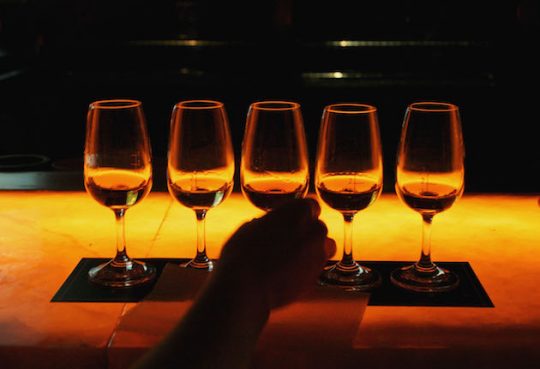Earlier this week I served as a judge for the World Whiskies Awards, to which friends and colleagues expressed all manner of encouragement. "Lucky you!" said one. "Lucky bastard," joked another. "F—ing outrage," said Washington Free Beacon executive editor Sonny Bunch. Unless you’re a teetotaler, it’s a terrific gig, I get it. But, honestly, rating whiskies from 10 in the morning 'til 3 in the afternoon is hard work.
Oh, good, you’re still reading! As I said, it’s tough being a judge of good whiskey. First off, there’s the quantity: We were broken up into tables of three and four judges and assigned different categories. My table handled two sets of rye (this worked out considering I just wrote on the subject), corn, three-grain, and wheat. In other words, five rounds with each round consisting of anywhere from four to nine glasses. Fortunately each table had carafes of water and a basket of crackers, both of which I consumed plentifully—especially the salty crackers. At some point, I pondered, there must be a cracker competition going on somewhere and the judges are cleansing their palates with bourbon.
In addition, there was a buffet lunch and spit cups. I never did make use of the latter but, on the other hand, I never finished any of my 30 or so glasses.
This brings me to the tasting itself. My main concern was having drastically different responses to the spirits from those of my fellow judges—one is a distiller and the other a whiskey writer based in Louisville. We agreed to sample in silence and at the end compare notes.
Crème anglaise. Burnt caramelized sugar. Saddle leather. Those were just some of the words used by my fellow judges to describe our whiskies. My initial descriptions, on the other hand, included "edgy," "spicy," "high alcohol," and "slight burn." But we also had a numeric component—scoring each sample on a scale of 0-10, decimals permitted. This is what I truly feared: that the other judges’ scores would be radically opposed to mine. But, as it turned out, we had fairly similar scores.
On two occasions we identified the same sample of something none of us liked—either it was not in the right category or there was something off about it. My colleagues’ descriptions were far better than mine, including "burnt rubber," "plastic bags burning in a campfire," and "Band-Aids." Beware of the smell of ripe bananas, warned one of the judges, as it may be an indicator of heads and not hearts. Perhaps the whiskey spent too much time in the barrel? It could also be a cooperage problem.
After a few sips, I started to pick up the nuances. I remembered to make observations on the color, character, nose, complexity, and finish. My tasting notes had words like "caramel corn" and "apples." And I’d notice one of the judges had likewise written down these same words. It was reassuring (but again, our scoring was fairly similar throughout).
Just when we thought it was over, we learned there would be a few tie-breaker rounds. In one of these categories, a truly outstanding traditional bourbon was pitted against one with a rather startling flavor profile. In the end, I said it reminded me of grass—verdant and undulating. At least that’s the image that came to my mind. One table over a judge mentioned "grass" as well. None of us knows the identities of these whiskies, but that last one I hope to encounter again.
We judged American whiskies, but there were other competitions going on in Canada and Japan. Our nominees go on to England for the finals. But as our generous hosts reminded us, the true winners are supposed to be the consumers. Our aim was to single out whiskies we think others would want to try at a bar or purchase at their local liquor stores. I hope we did just that.
